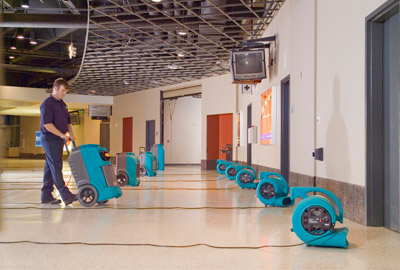Three Phases of the Water Damage Drying Process
Our goal to restore your property as quickly and efficiently as possible. The exact details of the restoration process differ according to each unique water loss, but they fall into three general phases.
 Emergency Service – Phase 1
Emergency Service – Phase 1
When our team first arrives, a Statement of Authorization needs to be signed so we can begin work. Once we have full permission to begin work, a licensed technician inspects the affected area and determines what next steps are necessary. If there is standing water, the technician will start by extracting the water. Next, they will determine if finished floors, cabinets, and other materials can be salvaged, and the best method for doing so.
Some important factors to keep in mind:
The most important element in your home to dry is the building’s structure itself. Wet structural elements such as the sub-floor can lead to mold, and can cause structural instability in the long-run. We are equipped with specialized moisture meters to determine the level of moisture present for both surface and internal structures.
Commercial grade air movers and dehumidifiers are set up in the affected area to remove excess moisture from carpet, sub-flooring, and other building materials efficiently and effectively. For successful drying, these machines must be left to run 24/7 until the dry-out is complete.
If the carpet pad is wet and it cannot be effectively dried in place, we lift the carpet and remove the wet pad. We then take a sample of the pad to order the correct material for reinstalling the carpet. If the carpet itself cannot be rescued, the technician will inform the customer and insurance company. Once authorization is given, the carpet and pad will both be removed.
Phase 2 – Structural Repairs
Depending on the severity of the damage, structural repairs may be necessary once the drying is complete. Any damage to the drywall, flooring, ceilings, or other structural elements will be repaired or replaced.
Phase 3 – Reinstallation/Cleaning
If the carpet can be dried in place, it will have to be cleaned and deodorized when the drying is completed. When the carpet pad must be removed the salvage the carpet, we will then need to install replacement pad and reinstall the actual carpet. This includes stretching the carpet, repairing seams, and reattaching the tack strip. Once in place, the carpet will be cleaned and deodorized. Any furniture or upholstery present in the space will also be cleaned.
